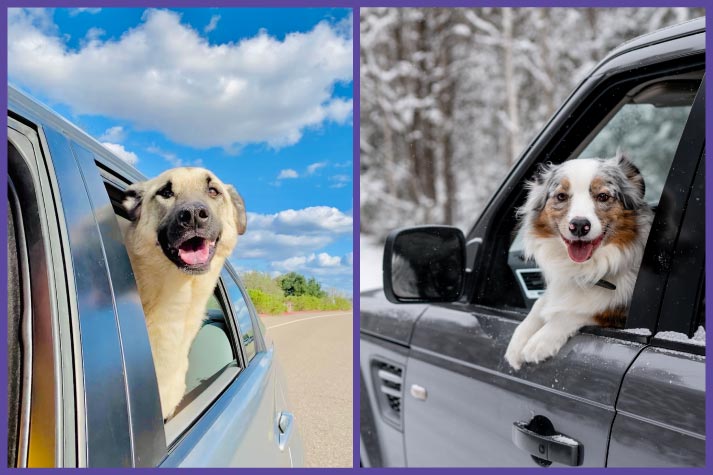
18 Sep
Pet Relocation During Summer and Winter: Weather-Related Tips and Precautions
Spending time outdoors with your pets is always a wonderful experience. Whether it’s a run during cold winter months or relaxing in the shade on a sunny day, being outdoors is always fun. However, extreme weather conditions can be risky for dogs and cats, and it is important to know what steps to take when staying outdoors or travelling during summer or winter. Here are some key things to keep in mind when relocating your pet during the hot summer months.
Heatstroke in Pets
Pets can suffer from heatstroke when their body temperature rises too high. Normally, dogs and cats have a body temperature between 100-102.5°F. If a dog’s temperature reaches 108°F or a cat’s hits 106°F, they can experience organ damage or even death. Signs of heatstroke include heavy panting, weakness, rapid breathing, a dark purple tongue, or vomiting.
If your pet shows any such signs, move them to a cooler area immediately. Gently cool their ears, belly, and paws with cool (not icy) water. Avoid dunking them in cold water or using cold blankets. Once they seem stable, take them to a vet, as internal damage may not be obvious.
Simple Summer Pet Safety Tips
Follow these tips to protect your pets from the heat:
- Keep pets indoors during the day: When the sun is high, it’s best for pets to stay inside. Brief outdoor bathroom breaks are fine, but stick to shady areas as much as possible.
- Ensure shade and water outside:If your pets must be outside, make sure they have access to shade all day and plenty of fresh, cool water. Refill their water often, as warm water can be unappealing for thirsty pets.
- Exercise at cooler times: Walk or play with your pets early in the morning or later in the evening, avoiding the hottest part of the day. Older dogs, those with thick fur, or breeds with short noses (like pugs or boxers) are especially sensitive to heat.
- Protect their paws: Pavement, sand, or even dirt can become scorching hot and burn your pet’s paws. If it feels too hot for your hand, it’s too hot for your pet.
- Consider pet sunscreen: Ask your vet if your pet needs sunscreen, especially if they have thin coats or are prone to sunburn.
- Never leave your pet in a parked car: When temperatures rise above 70°F, leaving pets in the car is extremely dangerous, even with the windows cracked. Dogs and cats can’t sweat like humans, so they overheat quickly in confined spaces.
Winter Is Right Around the Corner
Winter may seem like the perfect time to plan your pet’s relocation. After all, you can sync it with your holiday travel plans and avoid the summer heat restrictions that often complicate things. But is colder weather actually better for your pet’s journey? Not necessarily. Winter brings unpredictable weather, which can create unique challenges when ensuring a safe trip for your furry friend.
Here are some key things to keep in mind when relocating your pet during the winter months:
Airlines and Winter Pet Travel Rules
At first, it might sound like good news that many airlines don’t have strict rules for pet travel in winter. However, this also means that even the most intricate plans can be disrupted by sudden weather changes.
In the summer, we know to expect heat embargoes and plan around them by avoiding specific airports or travel times. But winter storms, blizzards, or extreme cold can pop up unexpectedly, making it difficult to anticipate every issue.
Some pet friendly airlines have pet policies preventing pet travel in temperatures below 10°F to minimize weather-related delays or cancellations. Still, such policies can't always catch every weather situation in advance, so last-minute changes are still a possibility.
Stay Flexible with Your Plans
Since winter weather can be unpredictable, it's important to remain flexible with your travel dates and even the airports you're using. If a severe storm is predicted for a certain week, see if you can shift your pet’s travel to a different date. For international pet relocation, this can be more complicated, as health certificates and government approvals often have expiration dates. However, it’s always better to delay the trip than risk putting your pet through extreme conditions.
Talk to Your Vet
Some pets don’t cope well with cold weather. For example, older pets with arthritis may find their symptoms worsening in colder temperatures, making travel more stressful for them. Additionally, certain breeds are more sensitive to temperature changes and may struggle with the combination of car rides and flight times. It’s a good idea to consult your vet before making any travel decisions to ensure your pet’s comfort and safety.
Winter Pet Travel Checklist
- Add extra warmth: Line your pet travel crate with an extra blanket to keep them cozy.
- extra food: In case weather delays extend the trip, having extra food on hand is always a good idea.
- Don’t forget the leash: This is a year-round reminder, but it’s surprisingly easy to forget during holiday season.
- Avoid holiday travel: With busy airports and office closures, traveling around the holidays can add unnecessary complications.
By keeping these tips in mind, you can help make your pet’s winter travel experience as smooth and stress-free as possible.






AUTHOR’S BIO
Carry My Pet
Passionate pet enthusiasts and globetrotters, dedicated to easing furry friends' journeys worldwide. Penning tales of compassion at CarryMyPet, where every relocation is a tail-wagging adventure.